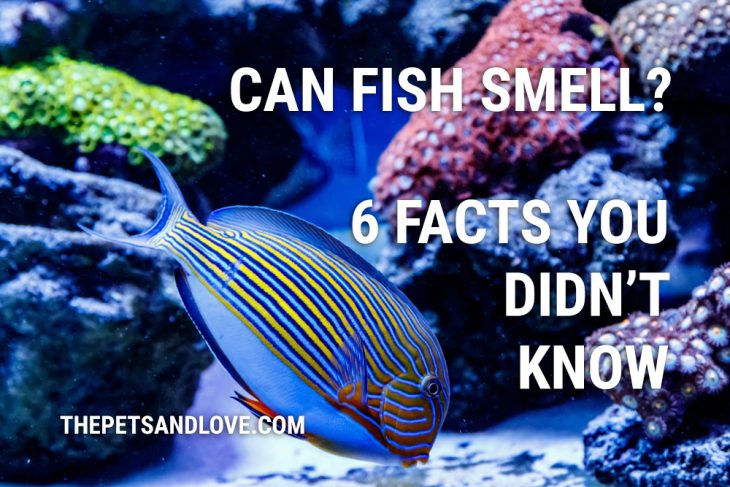6 Fascinating Facts About Fish and Their Incredible Sense of Smell


Most people are familiar with the old wives’ tale that sharks can smell blood a mile away. This actually isn’t true for most sharks, except for some species, like the lemon shark.
Such myths raise a more relevant question: can fish smell at all? The short answer is yes, but not exactly in the same way mammals do.
In the case of sharks, sense of smell varies greatly depending on the species. Here are a few fast facts:
- The organic chemicals in human sewage attract sharks. Technically, it’s not the sewage itself that attracts sharks. Rather, it’s the intestinal chemicals contained within. (Actually, sewage wouldn’t give off the same icky scent to a fish — keep reading to find out why.)
- The nostrils of a hammerhead shark give it an advantage. Check out the hammerhead shark below. Because of the unique shape of its head, its nostrils are spaced further apart. This allows it to quickly identify prey and pick up scents trails which might have scattered.
- Hammerhead sharks can smell one scent molecule in 100 billion molecules of water. So yes, there is some truth to the old wives’ tale that sharks have a sharp sense of smell, but they can’t smell quite as far as a mile away.
- Strength matters less than timing. Researchers with the U.S. Navy discovered that sharks will follow a scent based on timing rather than the strength of the scent. In other words, if sharks pick up a weak scent trail from their left nostril first, they’ll turn to the left, even if a stronger scent trail materializes on the right.

Did you know? We only recently discovered fish can smell.
People believed that fish couldn’t smell at all until 1924. According to an article published in Mètode, a scientific journal produced by the University of Valencia in Spain, a man named Fritz Strieck was the first to prove that the common minnow could smell.
Since then, scientists and ichthyologists have uncovered some incredible facts about how a fish’s sense of smell works.
Here are 6 interesting facts you might not know about how fish use their sense of smell to survive and thrive underwater.
How does a fish’s olfactory senses work?
The answer to this question isn’t clear-cut. It all depends on the species and how their olfactory systems operate.
Fish don’t have “noses” per se. Instead, they have “nares”, tiny nostrils located near the fish’s eyes.
Unlike humans, fish don’t use their nostrils to breathe in oxygen. They absorb oxygen through their gills. Instead, a fish’s olfactory system detects chemical signals in the water.
These chemical cues can send a variety of messages to the brain. Some “scents” warn fish of danger, while other scents act like a navigation system.
This is true for salmon, who return to the freshwater river in which they were born during mating season.

In 1978, a famous freshwater ecologist named Arthur Hasler discovered that the “scent” of a salmon’s home river imprints itself into their bodies.
Salmon navigate the ocean using the Earth’s magnetic field. Once they reach freshwater, they use their olfactory systems to locate the unique chemical scent of the stream where they were born.
Some fish, like catfish, combine their sense of smell and taste to navigate their environment. Ichthyologists call this phenomenon “chemoreception.”
Chemoreception allows fish, notably catfish, to “taste” items without even biting them. If you placed a catfish on top of a piece of food, for example, it would be able to taste it just from making contact.
Chemoreception is also incredibly useful for all sorts of things, including detecting danger, finding food, traveling to spawning sites, and locating other fish within the same species.
Pretty cool, right? Now that you know how fish use their sense of smell, let’s delve into some other cool facts about the fish’s olfactory system.
Fish fact #1: Some fish can smell without moving.
To humans, whose sense of smell works around the clock, this might not sound super fascinating. Many fish species need to move their bodies through the water to activate the olfactory tissues in their nares.
However, some fish, like zebrafish and salmon, can “smell” chemical signals without moving their bodies at all, thanks to sensory organelles called motile cilia. These mobile, microscopic “hairs”, somewhat similar to our own nose hairs, aid in scent detection.
The motile cilia are located in ciliated cell membranes found in the epithelial nose tissues. These organelles are constantly moving, “beating” in an irregular rhythm to create a flow of water — kind of like a turbine.
This flow then delivers chemical signals from the water to the brain. It also increases the fish’s olfactory sensitivity, allowing them to identify changes in odor and react to stimuli much more quickly.
In other words, if danger is lurking nearby, a fish species with motile cilia can detect it and flee to safety much quicker than those without.
Fish fact #2: Different species have different sensitivities to smells.
Not all olfactory systems are created equal. When fish use their sense of smell, water travels through the nostrils to the sensory organs, housed in an anatomical structure called the rosette.
Depending on the species, the number of sensory cells and folds in the rosette varies. In certain species, like the lizardfish, the number of sensory cells increases as the fish grows.
Channel catfish have the most sensory folds of any freshwater fish at 140, while pike have only nine folds on average.

Catfish have some of the sharpest senses of any fish. Their chemoreception abilities work as far as 15 feet away,
Catfish can also smell a substance at a rate of one part per 100 million. The American eel has the most sensitive olfactory abilities, and can detect substances at a rate of one part per trillion.
Bullheads have a weaker sense of smell, but their olfactory senses are unique for a few reasons. Firstly, groups of bullhead use a social hierarchy similar to some human cultures, and sense of smell plays a key role in maintaining that hierarchy.
To compare, consider the social status of say, the Queen of England to that of a middle-class worker. Now imagine that the Queen gave off a unique scent which indicates her status to the working class.
That’s how the bullhead social class system works. Bullheads can tell the social status of an individual fish just by the scent they give off!
Fish fact #3: Baby coral fish can find their way back home within 20 days of birth.
It turns out that it’s not just salmon who follow their noses, so to speak, to find their way back home.
In 2007, researchers studying coral fish in Australia’s Great Barrier Reef discovered that many species of fish can find their way back to their home reef using just their sense of smell. These include tiny damsel and cardinal fish.

Due to the strong currents of the waters near the Great Barrier Reef, baby fish are often carried away within days of hatching. Yet multiple species of fish managed to follow their nares back home within as few as 20 days of birth.
After multiple experiments, the researchers concluded that many fish follow currents which carry the same “chemical signature” as their home reef, rather than relying on sight or hearing.
Fish fact #4: Certain acids create “scent trails” for fish.
When we humans catch a whiff of something cooking in the kitchen, it often triggers reactions in our bodies. Our stomach might rumble, our mouth might water. The important thing is, we know from the smell that food is nearby, and our bodies react accordingly.
A fish’s sense of smell works in a similar way. Most popular fish baits secrete amino acids, which signal to the fish that food is nearby. Some fish have a higher sensitivity to amino acids.
Bile acid, on the other hand, is a chemical produced by a fish following digestion. If a fish picks up a scent trail of bile acid, they’ll know feeding has occurred recently in the area. This usually indicates that it’s a good spot to feed in the future.
Fish can even smell the intestinal fluids of other fish, including those outside their own species. Interestingly, this allows them to “recognize” other fish.
Just like we might recognize someone based on the cologne or perfume they wear, so too can fish identify their friends just by the way they smell. Neat!
Fish fact #5: Some fish can smell ATP.
What is ATP? Think back to chemistry class. ATP stands for adenosine tri phosphate.
Put simply, this molecule stores the energy which powers just about every cellular process in living beings — sort of how a gas tank stores the fuel needed to power a car.
Remember earlier in the article when I said that fish can smell certain acids? It turns out some fish even smell microscopic cellular structures like ATP.
In 2017, a study conducted by neurobiologists at the RIKEN Brain Institute in Japan found that zebrafish can smell ATP released by zooplankton.

The neurobiologists identified a specific receptor in the zebrafish’s olfactory system, called A2c, which allows them to pick up this “scent” and track down their prey.
What’s more, the A2c gene is present only in fish and an amphibian genus called Xenopus. Commonly known as “the clawed frog,” this genus contains 20 species of aquatic frogs native to Africa.
This suggests that this A2c is unique to fish and other aquatic animals, although scientists are still researching this fascinating gene.
Fish fact #6: Climate change is affecting many species’ sense of smell.
A fish’s sense of smell is a pretty cool phenomenon. Unfortunately, though, climate change is harming the olfactory capabilities of many fish living in our oceans.
According to EcoWatch, carbon dioxide released from carbon emissions mixes with seawater to create a harmful substance called carbonic acid.
In a collaborative study, researchers in Portugal and the UK found that European sea bass living in highly acidic waters didn’t respond to the smell of a predator.
Granted, this experiment took place in waters which are about two times more acidic than today’s oceans. However, the test aligns with predictions about carbon dioxide levels in Earth’s oceans by the end of the 21st century.
This is an alarming fact to note, considering that 75% of life on earth lives underwater. Not only does this affect the fish themselves, but it affects us as well.
Three billion people, just under half of the current total human population, rely on seafood for 20% of their protein intake.
The researchers estimated that the same phenomenon will affect not only sea bass, but crabs, lobsters, and many other species as well.
Wrapping up
On that slightly sad note, it’s plain to see that a fish’s sense of smell is a fascinating phenomenon that expert marine biologists still don’t fully understand.
Indeed, much of the information available on a fish’s sense of smell is highly specialized and may be inaccessible to the average reader who, like myself, is unfamiliar with the complex processes of marine biology.
I’ve tried my best to make sense of the scientific jargon and present some super cool facts about the fish olfactory system in layman’s terms.

I’ll leave you with one last fact. Remember how I said at the beginning of the article that sewage doesn’t smell the same to sharks as it does to humans?
That’s because fish can’t detect volatile molecules using their olfactory senses. In simple terms, that means fish can’t smell airborne chemicals. They can only detect scents that dissolve in water.
So the next time you go fishing and you’re tempted to use a “smelly” bait, remember that it might not work on your target fish.
Indeed, for some fish, sight trumps smell. While catfish can smell food 100 yards away even in a highly polluted river, some fish, like bass, are more attracted to the way lures move rather than how they smell.
And there you have it: a handful of cool facts about the fish olfactory system that you (probably) didn’t know. For all you fishing fanatics out there, stay tuned to see what scientists discover next about this mind-boggling phenomenon.
References:
https://www.sciencefocus.com/the-human-body/how-do-sharks-smell-blood-underwater/
https://evolutionnews.org/2017/01/these_fish_have/
https://reader.elsevier.com/reader/sd/pii/S0960982216313896
https://www.ecowatch.com/fish-sense-of-smell-2591835774.html
https://www.sciencedaily.com/releases/2007/01/070122122455.htm
https://www.the-scientist.com/the-literature/fish-smell-atp-to-find-food-30986
https://www.cell.com/current-biology/fulltext/S0960-9822(17)30423-2
https://www.in-fisherman.com/editorial/catfish-senses-sensibilities/153986
https://fishgame.com/2013/10/can-fish-smell/
https://www.insidescience.org/news/why-hammerhead-sharks-have-wide-nose
https://www.sharks-world.com/shark_senses/
